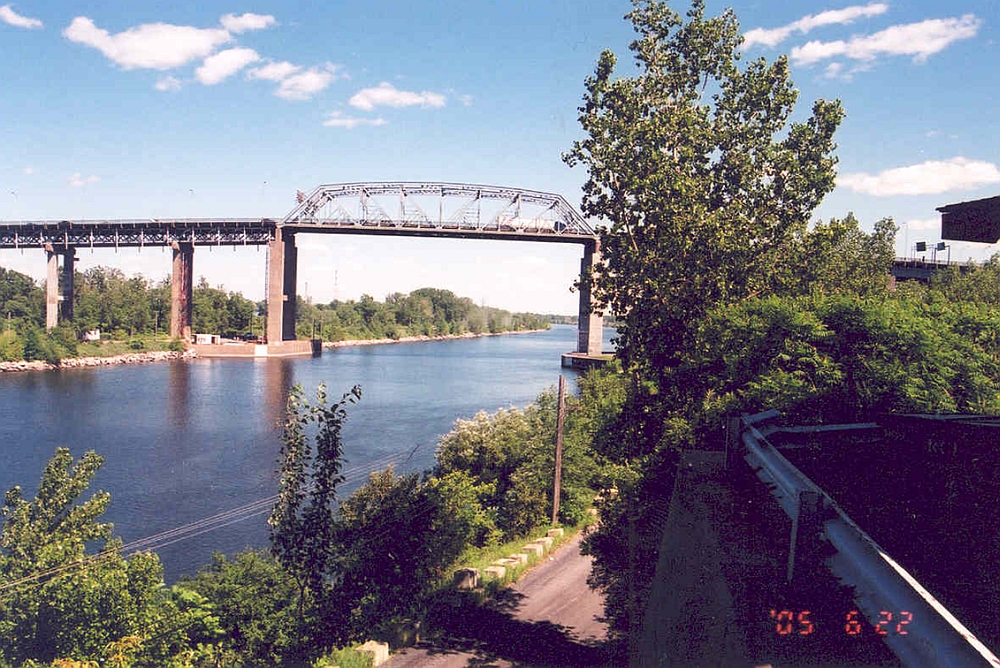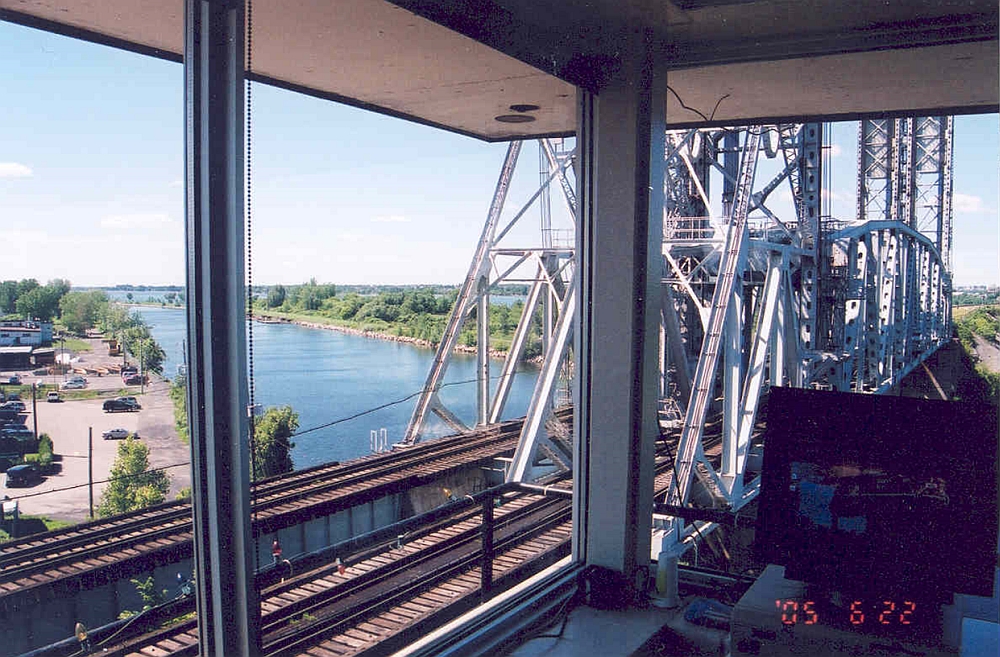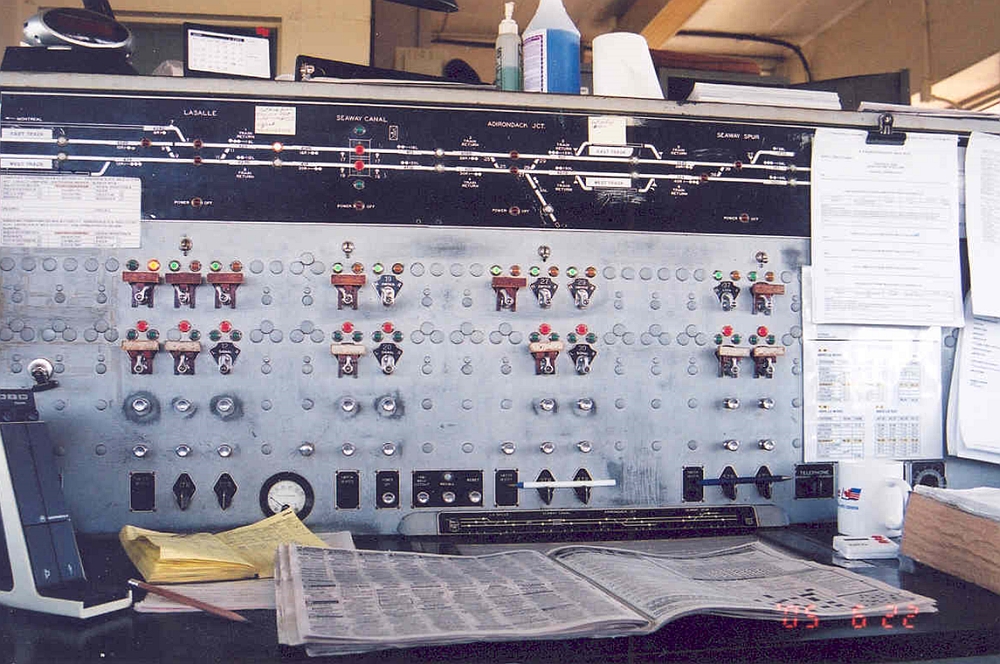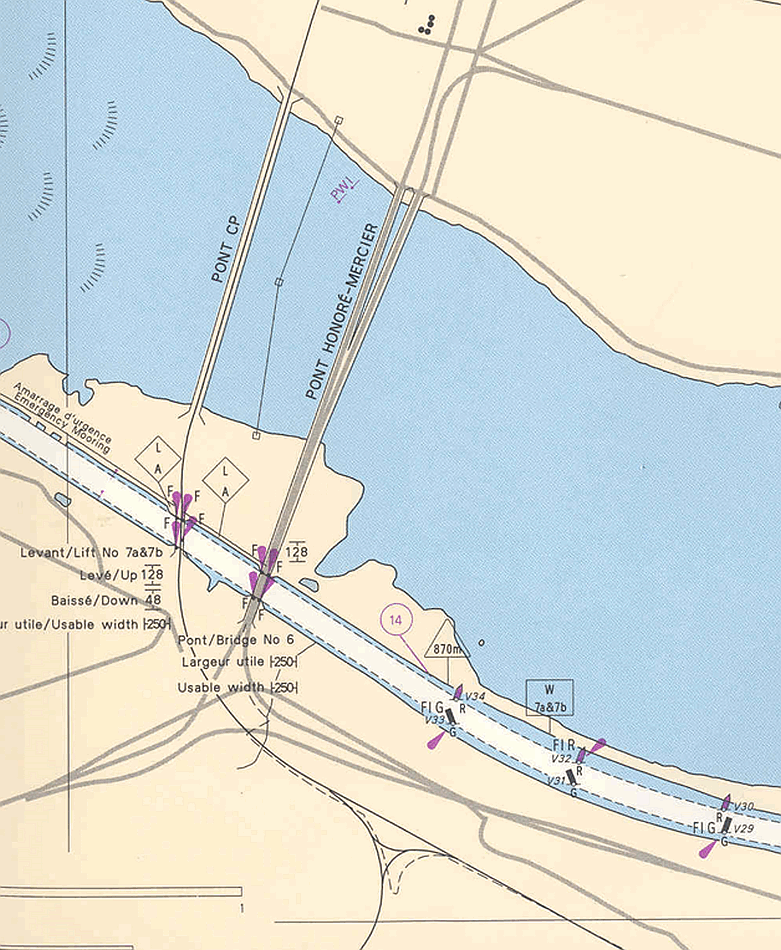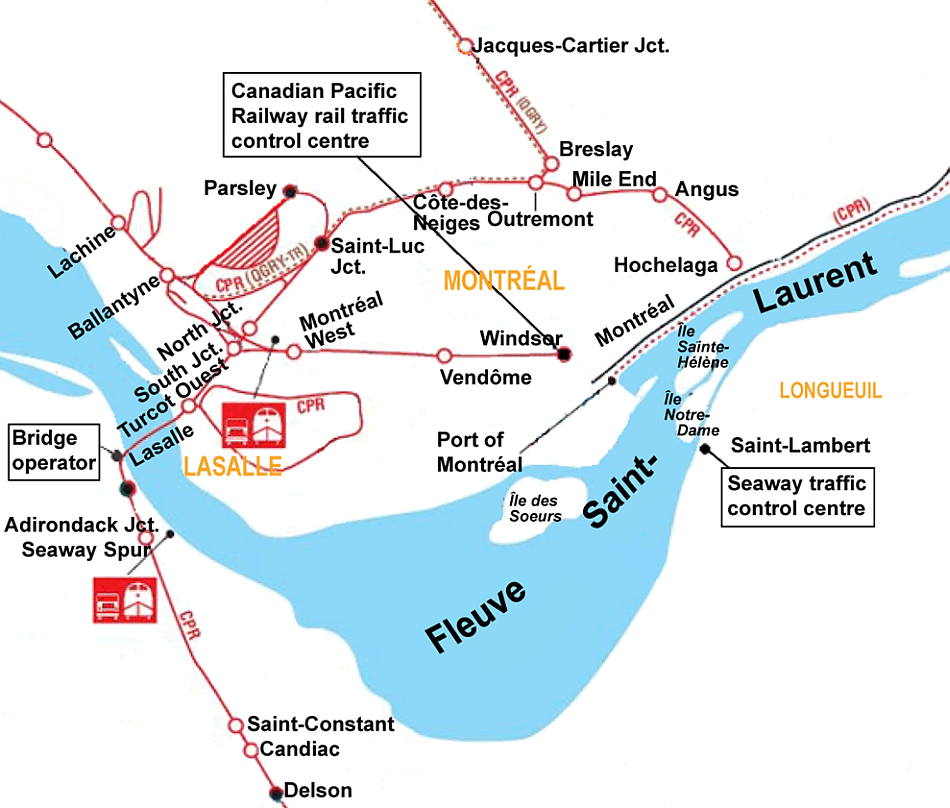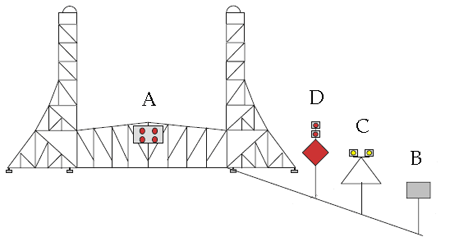Striking
Bulk carrier Federal Sakura
South Shore Canal
St. Lawrence Seaway
The Transportation Safety Board of Canada (TSB) investigated this occurrence for the purpose of advancing transportation safety. It is not the function of the Board to assign fault or determine civil or criminal liability. This report is not created for use in the context of legal, disciplinary or other proceedings. See Ownership and use of content. Masculine pronouns and position titles may be used to signify all genders to comply with the Canadian Transportation Accident Investigation and Safety Board Act (S.C. 1989, c. 3).
Summary
As the Federal Sakura proceeded upstream towards the Canadian Pacific Railway (CPR) bridges 7A and 7B, the vessel's bridge team noted that the signal lights on Bridge 7A were still red. The pilot then attempted to contact the bridge operator, but there was no response. The decision was made to stop the vessel under the Honoré-Mercier Bridge, downstream from bridges 7A and 7B. There was no headway, but the stern of the vessel brushed against the south pier of the Honoré-Mercier Bridge.
After the operator of bridges 7A and 7B took ill, he was replaced by another bridge operator, who immediately activated the signal for train 89 operated by the Agence métropolitaine de transport (AMT 89) to proceed on Bridge 7A. Subsequently, the bridge operator released Bridge 7A's emergency stop push button and started raising the lift span to allow the Federal Sakura to continue its voyage.
Factual information
Particulars of the vessel
| Vessel name | "FEDERAL SAKURA" |
|---|---|
| IMO number and official number | 9288291 / 30589-05 |
| Port of registry | Panama |
| Flag | Panama |
| Type | Bulk carrier |
| DeadweightFootnote 1 | 32 583 tonnes |
| Length | 190.04 m |
| Draught | Forward: 8.07 m Aft: 8.07 m |
| Cargo | 20 800 tonnes of steel billets |
| Built | 2005 |
| Propulsion | Low-speed marine diesel engine driving a propeller |
| Crew | 21 |
| Owners | Tateyama Naviera SA, Tokyo, Japan |
Seaway bridges and bridge operator's control tower
On the aboriginal reserve of Kahnawake, the Honoré-Mercier Road Bridge and the Canadian Pacific Railway (CPR) bridges 7A and 7B span the seaway's South Shore Canal.
The Honoré-Mercier Bridge, which for Seaway users is identified as Bridge 6, is part of the highway that links Longueuil to Montréal (see Photo 1). The twin CPR bridges, located upstream from the Honoré-Mercier Bridge, are equipped with a lift span to allow the passage of marine traffic. These bridges are used daily by freight trains as well as commuter trains operated by the Agence métropolitaine de transport (AMT) (see Appendix A).
A control tower sits on the south shore next to the CPR bridges. From the control position, the field of vision is such that it allows the operator to observe as much railway traffic as marine traffic (see Photo 2). There is a control system for raising the lift spans of bridges 7A and 7B and another for interlocking and switching tracks in the Seaway Canal, Adirondack Junction,and Seaway Spur zones. Lift span operations are carried out using a computer console. System programming was developed and is maintained by the St. Lawrence Seaway Management Corporation (SLSMC) (see Photo 3). Track interlocking and switching is done using switches on a mimic panel supplied and maintained by CPR (see Photo 4). Marine and railway systems must meet specific traffic conditions to allow the passage of either a vessel or a train. These two systems are interdependent in order to limit traffic to one mode of transport at a time.
Sequence of events
On 03 June 2005, downbound vessel Canadian Olympic and upbound vessel Federal Sakura were making way in the St. Lawrence Seaway. The two vessels were proceeding toward bridges 7A and 7B; the Canadian Olympic anticipated passing under the bridges at approximately 1718 eastern daylight time,Footnote 2 while the Federal Sakura anticipated its passage at approximately 1735.
At 1700, southbound AMT train 87 crossed Bridge 7A. After the train's crossing, the bridge operator raised the lift spans of bridges 7A and 7B in anticipation of the passage of the Canadian Olympic. As planned, at 1718, it passed under the bridges. Immediately following its passage, the bridge operator lowered the lift spans to allow AMT passenger train 89 southbound and AMT passenger train 90 northbound to pass over the bridges.
At 1723, the lift spans were fully lowered and, at 1728, the emergency stop push button was activated for Bridge 7A. This action eliminates all commands capable of moving the bridge span until the operator releases the button. At 1734, AMT train 89 arrived at Bridge 7A, but the locomotive engineer did not have the green light to cross the bridge. At 1735, AMT train 90 arrived at Bridge 7B and also encountered a red light (see Appendix C). At 1740, the rail traffic controller (RTC), based in Montréal, noted the stoppage of both AMT trains and attempted to telephone the bridge operator. At 1741, the RTC reached the bridge operator. The bridge operator was incoherent, and the RTC concluded that medical assistance was required. Accordingly, the RTC dispatched an ambulance as well as another bridge operator.
At 1736, the Federal Sakura, proceeding at a speed of 6.6 knots, met the Canadian Olympic below buoys V29 and V30, which are located approximately one nautical mile downstream from bridges 7A and 7B. Noting that bridges 7A and 7B were still lowered, the pilot of the Federal Sakura contacted Seaway Beauharnois to enquire about the situation. Seaway Beauharnois immediately attempted to reach the bridge operator by telephone and very high frequency (VHF) radiotelephone, but to no avail. The ship traffic controller then reached the security guard to check out the situation.
At 1745, when the Federal Sakura passed the whistle sign, approximately 0.71 nautical mile downstream from the bridges, the bridge team noted that the red signal lights on the CPR bridge were not flashing; flashing lights indicate that the lift span is being raised. The pilot called the bridge operator via radiotelephone on channel 14 VHF, but there was no answer. Then, the captain and the pilot decided to stop the vessel under Honoré-Mercier Bridge, which is located 0.16 nautical miles downstream from the CPR bridges. An emergency stop manoeuvre was undertaken; the main engine was reversed while the vessel was still proceeding at a speed of 5.2 knots; when the vessel passed under the Honoré-Mercier Bridge, the two forward anchors were dropped.
In the meantime, at 1752, the bridge operator managed to raise the lift span of Bridge 7B but was unable to raise the lift span of Bridge 7A. At 1758, the vessel had no headway, and the stern brushed the south pier of the Honoré-Mercier Bridge, without sustaining any damage. Subsequently, the vessel was manoeuvred to the centre of the channel, some 100 metres from Bridge 7A.
At 1805, the relief bridge operator arrived at the control station in the tower and immediately activated the signal to allow AMT train 89 to pass on Bridge 7A. Subsequently, the bridge operator released Bridge 7A's emergency stop push button and, at 1822, started to raise the bridge's lift span. At 1825, the red signal lights were deactivated and the green signal lights on the CPR bridges were activated. The vessel weighed its anchors and continued its voyage under the CPR bridges.
Meanwhile, the ambulance attendants assisted the bridge operator and transported him to Anna-Laberge Hospital in Châteauguay, Quebec.
Duties and medical condition of the bridge operator
The bridge operator is employed by CPR. He works as an Interlocking RTC at Seaway Interlocking and is supervised by the RTC of the Adirondack Subdivision. He maintains contact by telephone and radiotelephone with a marine traffic controller based at the Saint-Lambert traffic station (Seaway Beauharnois). Bridge operation along with track interlocking and switching are all performed by the bridge operator; presently, these duties cannot be performed remotely. In other words, the bridge operator operates the bridges, including rail signal and interlocking on his own - a condition prone to single-point failure, as in this occurrence.
Under Transport Canada Railway Rules Governing Safety Critical Positions,Footnote 3 an Interlocking RTC function is designated a safety-critical position.
In 2001, Transport Canada announced the coming into force of the Railway Medical Rules for Positions Critical to Safe Railway Operations, which established a new process for medical assessments and defined medical fitness for duty requirements. A manual was prepared to provide railway companies with the information needed to enforce said rules. In this manual, diabetes is referred to as a health problem to be assessed on an individual basis.
The bridge operator was diabetic and was being treated with insulin and an oral hypoglycaemic drug. He was under regular care of doctors, and the railway company had been aware of his medical condition since spring 2002.
According to the CPR's chief medical officer, the bridge operator most likely suffered a severe episode of hypoglycaemia, in modifying his diet in an attempt to lose weight, which affected his cognitive function including his alertness, judgment and insight, as a result of an abnormal lowering of blood sugar.
The security guard
The security guard is an employee of a security guard company contracted by the SLSMC. The position's duties include ensuring that no persons are on the lift spans before and during lifting. An audible signal warns the security guard when lift spans are going to be raised or lowered. He is not trained to perform the duties of the bridge operator. The security guard's working office building is separate from the bridge operator's office building.
Defence in the event of deficiencies
The two modes of transport share similar operating practices. Coupled with rail advance signs and marine lights and signs, red and green signal lights are used to designate which party has the right of way. The lights must be green to proceed on or under bridges. For rail traffic, trains must come to a complete stop before passing the governing red signal (see Appendix C); for marine traffic, vessels must stop (with or without dropping anchor) if the red light is in a steady mode (see Appendix D). In this case, the trains and the vessel were able to stop.Footnote 4
Similar occurrence
Similar circumstances to these were revealed in the investigation of bulk carrier Windoc's striking of the lift span of Bridge 11 in the Seaway's Welland Canal in 2001.Footnote 5 That investigation revealed the following:
- The operation of any lift bridge involves close interaction between the operator and traffic control centre personnel; the bridge operator represented the sole line of defence, someone who could - and was required to - ensure that the transit of the vessel under the bridge was carried out safely.
- It is likely that the operator's performance was impaired at the time of the occurrence.
- The SLSMC is responsible for operations and Seaway structure maintenance in Canada.
- Bridge operators very often work alone, thereby providing little opportunity for supervisors to ensure that operators are able to consistently perform their job functions in an appropriate and safe manner.
Following this occurrence, action was taken to improve bridge protection to avoid future contact with vessels passing through the Welland Canal. Motion detectors were installed to detect vessels passing under the bridges. The SLSMC also installed motion detectors to detect the presence of vessels passing under the bridges in the Montréal/Lake Ontario section, namely the Saint-Louis Bridge (Bridge 9), Valleyfield Bridge (Bridge 10), and CPR bridges 7A and 7B. At that time, the SLSMC was also developing plans for the remote operation of the Saint-Louis Bridge.
The following action has been taken by the SLSMC:
- The control centre must make random telephone calls to the bridge operators in the Montréal/Lake Ontario section.
- All free-standing lift bridges on the Welland Canal are now remotely operated from a control centre.
- The bridge operator is now required to make a VHF call to the vessel.
- At isolated free-standing lift bridges, the automatic identification system (AIS) is now used to alert bridge operators of an approaching vessel.
- A bridge operator is required to communicate with a vessel before lowering the bridge.
Findings
Findings as to causes and contributing factors
- The bridge operator fell ill, preventing him from continuing his duties, which included raising the lift spans during the Federal Sakura's approach.
- Since the red signal lights were lit, Agence métropolitaine de transport (AMT) train 89, AMT train 90, and the bulk carrier Federal Sakura did stop, but the bulk carrier brushed against the south pier of the Honoré-Mercier Bridge.
Findings as to risk
- Although medical monitoring was done in accordance with Railway Medical Rules for Positions Critical to Safe Railway Operations, the employee suffered a severe episode of hypoglycaemia, which affected his cognitive functions.
- Even though the vessel followed the procedures in place and stopped within the prescribed limits of approach, it could not remain in the centre of the channel and, as such, struck the bridge pier.
Other findings
- Even though a security guard was on duty in proximity to the bridge operator, security guards are not trained to perform the duties of bridge operators.
Safety action
Safety action taken
On 02 March 2006, the TSB issued Marine Safety Information (MSI) letter 02/06, "Single Point Failure in the Traffic System Affecting Rail Transportation on the Railways of the Adirondack Subdivision and Marine Transportation in the South Shore Canal of the St. Lawrence Seaway," to the St. Lawrence Seaway Management Corporation (SLSMC), Canadian Pacific Railway (CPR) and Transport Canada (TC). The MSI apprised of the importance of the bridge operator's performance in preserving safety.
CPR participated in a TC audit and observation of rail safety protection provided at CPR bridges 7A and 7B. TC and CPR assessed the existing measures and indicated that existing control systems, procedures, rules, and regulations in effect at the location constitute an appropriate level of safety for rail and marine traffic regulation.
Effective October 2006, Saint-Louis Bridge (Bridge 9), in the Montréal/Lake Ontario section, is remotely operated.
This report concludes the Transportation Safety Board's investigation into this occurrence. Consequently, the Board authorized the release of this report on .
Appendices
Appendix A - Sketch of the occurrence area
Appendix B - Location of the traffic control centres and the bridge operator tower
Appendix C - Operation of trains over drawbridge
The operation of trains approaching drawbridges is governed by the Canadian Rail Operating Rules (CROR) and railway special instructions. The principal rules that are applicable are CROR Rules 97, 98, the CROR Block and Interlocking Signals Rules 401 to 430 inclusive, and the CROR Interlocking Rules 601 to 620 inclusive. The Interlocking Operator at Seaway controls movements using his Interlocking Control Panel and trains enter and leave the interlocking, or are stopped at the control locations for the drawbridge as required, governed in most instances by the following CROR signal indications:
| RULE | ASPECTS | NAME | INDICATION |
|---|---|---|---|
| 405 | Clear Signal | Proceed. | |
| 410 | Clear to Stop | Proceed preparing to stop at next signal. | |
| 421 | Slow to Clear | Proceed, slow speed passing signal and through turnouts. | |
| 424 | Slow to Slow | Proceed, slow speed passing signal and through turnouts, approaching next signal at slow speed. | |
| 425 | Slow to Stop | Proceed, slow speed passing signal and through turnouts, preparing to stop at next signal. | |
| 426 | Restricting Signal | Proceed at restricting speed. | |
| 429 | Stop Signal | Stop. |
Appendix D - Procedure for vessel approaching bridges in the St. Lawrence Seaway
To provide approaching vessels with information on the status of the bridge, an identical set of signal system is provided on both sides of each bridge. At all bridges, the signal system on each side of the bridge is identical. It consists of navigation lights mounted on the bridge, a set of three signs at varying distances from the bridge, and a set of controls and indicators in the bridge control room to operate and monitor the navigation lights. For each bridge, the post sign distance is determined in function of the currents and the normal vessel speeds in order to provide safe stopping distance to vessels (see Figure 1).
The whistle sign (B) serves as a reference point for the beginning of the operation of the bridge. When the approaching vessel is at or just before the whistle sign, the bridge operator activates the signal light system, thus indicating to the vessel that the bridge has recognized its approach. Distance from whistle sign to above and below bridges 7A and 7B are 0.75 and 0.71 nautical mile (nm) respectively.
The caution sign (C) serves as a reference point for the bridge operator and the vessel. The bridge operator must have the bridge in the fully raised position to pass a vessel not later than when the stem of the vessel is at the caution sign. If the bridge is not fully raised by the time the vessel is at the caution sign, the vessel is to take whatever evasive action deemed necessary to bring the vessel to a stop without passing the limit of approach (L/A) sign. Distance from caution sign to above and below bridges 7A and 7B is 0.55 and 0.50 nm respectively.
The L/A signs (D) serve as a reference for the vessel only. No vessel is to pass the limit of approach sign until the bridge is fully raised and the GREEN navigation lights are displayed. Distance from L/A sign to above and below bridges 7A and 7B are 0.03 and 0.03 nm respectively.
